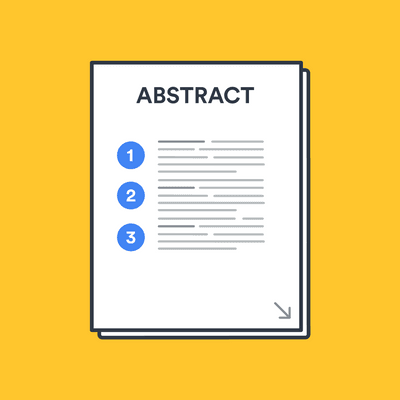How to write an abstract

What is an abstract?
An abstract is a summary of the main contents of a paper.
The abstract is the first glimpse that readers get of the content of a research paper. It can influence the popularity of a paper, as a well-written one will attract readers, and a poorly-written one will drive them away.
➡️ Different types of papers may require distinct abstract styles. Visit our guide on the different types of research papers to learn more.
How to write an abstract
Before you actually start writing an abstract, make sure to follow these steps:
- Read other papers: find papers with similar topics, or similar methodologies, simply to have an idea of how others have written their abstracts. Notice which points they decided to include, and how in depth they described them.
- Double check the journal requirements: always make sure to review the journal guidelines to format your paper accordingly. Usually, they also specify abstract's formats.
- Write the abstract after you finish writing the paper: you can only write an abstract once you finish writing the whole paper. This way you can include all important aspects, such as scope, methodology, and conclusion.
➡️ Read more about what is a research methodology?
General format of an abstract
The general format of an abstract includes the following features:
- Between 150-300 words.
- An independent page, after the title page and before the table of contents.
- Concise summary including the aim of the research, methodology, and conclusion.
- Keywords describing the content.
The content of an abstract
As mentioned before, an abstract is a text that summarizes the main points of a research. Here is a break down of each element that should be included in an abstract:
- Purpose: every abstract should start by describing the main purpose or aim of the research.
- Methods: as a second point, the methodology carried out should be explained.
- Results: then, a concise summary of the results should be included.
- Conclusion: finally, a short outline of the general outcome of the research should be given.
- Keywords: along with the abstract, specific words and phrases related to the topics discussed in the research should be added. These words are usually around five, but the number can vary depending on the journal's guidelines.
Abstract example
This abstract, taken from ScienceDirect, illustrates the ideal structure of an abstract. It has 155 words, it's concise, and it clearly shows the division of elements necessary to write a successful abstract.
This paper explores the implicit assumption in the growing body of literature that social media usage is fundamentally different in business-to-business (B2B) companies than in the extant business-to-consumer (B2C) literature. Sashi's (2012) customer engagement cycle is utilized to compare organizational practices in relation to social media marketing in B2B, B2C, Mixed B2B/B2C and B2B2C business models. Utilizing 449 responses to an exploratory panel based survey instrument, we clearly identify differences in social media usage and its perceived importance as a communications channel. In particular we identify distinct differences in the relationship between social media importance and the perceived effectiveness of social media marketing across business models. Our results indicate that B2B social media usage is distinct from B2C, Mixed and B2B2C business model approaches. Specifically B2B organizational members perceive social media to have a lower overall effectiveness as a channel and identify it as less important for relationship oriented usage than other business models.
Abstract style guides
The exact format of an abstract depends on the citation style you implement. Whether it’s a well-known style (like APA, IEEE, etc.) or a journal's style, each format has its own guidelines, so make sure you know which style you are using before writing your abstract.
APA is one of the most commonly used styles to format an abstract. Therefore, we created a guide with exact instructions on how to write an abstract in APA style, and a template to download:
📕 APA abstract page: format and template
Additionally, you will find below an IEEE and ASA abstract guide by Purdue Online Writing Lab:
📗 IEEE General Format - Abstract
📘 ASA Manuscript Formatting - Abstract
Frequently Asked Questions about writing an abstract
🏖️ Should I write an abstract before the discussion of the paper?
No. You should always write an abstract once you finish writing the whole paper. This way you can include all important aspects of the paper, such as scope, methodology, and conclusion.
🐚 How long should an abstract be?
The length of an abstract depends on the formatting style of the paper. For example, APA style calls for 150 to 250 words. Generally, you need between 150-300 words.
🌊 Should I include an abstract in my table of contents?
No. An abstract has an independent section after the title page and before the table of contents, and should not be included in the table of contents.
⛱️ How do I format an abstract in APA style?
Take a look at APA abstract page: format and template for exact details on how to format an abstract in APA style.
🌴 Where can I find examples of abstracts?
You can access any paper through Google Scholar or any other search engine; pick a paper and read the abstract. Abstracts are always freely available to read.


